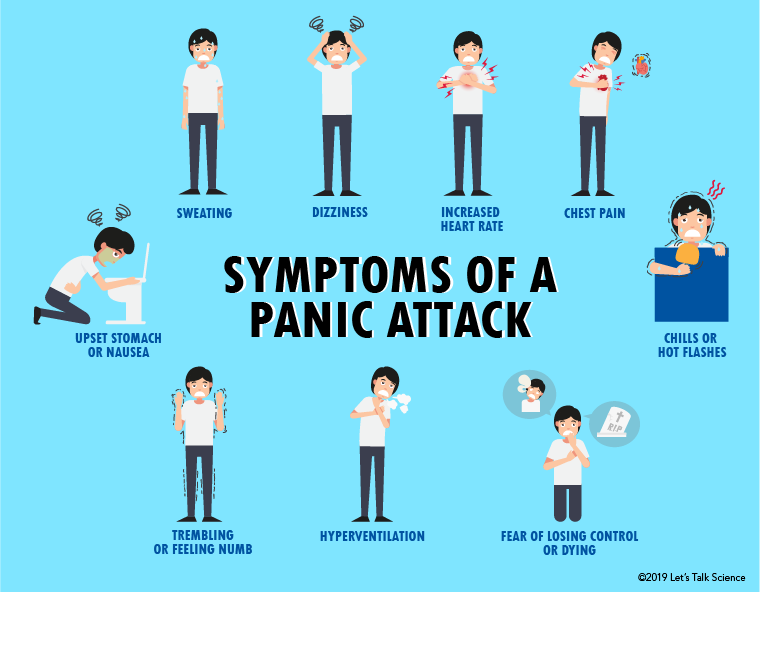Chemical Equilibrium and Panic Attacks

Woman having a panic attack (Tero Vesalainen, iStockphoto)

Woman having a panic attack (Tero Vesalainen, iStockphoto)
How does this align with my curriculum?
| Grade | Course | Topic |
|---|
Panic attacks are scary and they upset your body’s chemical equilibrium. Learn what happens to acids & bases in your circulatory system during a panic attack.
Imagine you’re in the middle of a crowded place with some friends. Maybe you’re at the mall, or in the hallway at school. All of a sudden, you feel dizzy. Your chest starts to hurt. You start to take quick shallow breaths, and you can’t feel your fingers. It feels as if the world around you isn’t real—as if you’re in a dream. “Am I going crazy?” you think to yourself. “Am I having a heart attack? Am I dying?”
No, you’re not dying. You’re having a panic attack. It’s a very unpleasant experience. But it’s not an uncommon experience. Let’s learn about what a panic attack is, and what happens in your body when you have one.
What is a panic attack?
When you sense danger, your body goes into emergency mode. The sympathetic nervous system, your body’s emergency response system, kicks in. It makes your heart beat faster. It makes you breathe more quickly. This is called the fight-flight-freeze response. It helped our ancestors prepare to react to a dangerous situation.
When there is actual danger, a faster heartbeat and quicker breathing are useful. They get more oxygen to our muscles so we can react to the danger.
But sometimes, our bodies send out false alarms. Panic attacks are basically just a false alarm from our fight-flight-freeze response. When there’s nothing dangerous to react to, this can lead to a panic attack.
Are panic attacks and anxiety the same thing?
No, they are not. Panic attacks are intense and sudden periods of fear. Typically, panic attacks last around ten minutes or less. Also, panic attacks do not necessarily result from a specific worry.
On the other hand, anxiety is more of a consistent feeling of worry, usually around a particular future event. For example, you might feel anxiety if you have to give a presentation to your class.
What are the symptoms of a panic attack?
Not everyone experiences panic attacks the same way. Below is a list of common panic attack symptoms. If you’re feeling at least four of them, you may be having a panic attack.
Symptoms of a panic attack include:
-
Sweating
-
Dizziness
-
Increased heart rate
-
Chest pain
-
Chills
-
Hot flashes
-
Nausea
-
Numbness
-
Hyperventilation
-
A fear of losing control or dying

Did you know?
If you have panic attacks often, you may have a type of anxiety disorder called panic disorder
Around 4% of Canadians have panic disorder. Occasional panic attacks are even more common, with around 11% of people experiencing sporadic panic attacks per year. In a school of 100 people, that would mean eleven people may experience panic attacks. Four of those people may have panic disorder!
What is happening in your body when you have a panic attack?
Some people hyperventilate when they have panic attacks. When you hyperventilate, you take very quick, shallow breaths. Hyperventilation causes chemical changes in the body. These chemical changes lead to what is called respiratory alkalosis. This a temporary condition and involves an increase in blood pH due to loss of carbon dioxide. But how does hyperventilation cause respiratory alkalosis?
Normally, our blood pH level is 7.4, or very slightly basic. This pH level is kept in place by a system in our body called the bicarbonate system.The bicarbonate system involves chemical reactions between water, carbon dioxide, carbonic acid, hydrogen ions and bicarbonate molecules.

The chemical equation for the bicarbonate system involves H2O combining with CO2 to form H2CO3 which in turn can decompose to form H+ ions and HCO3- molecules.
What does this equation actually tell us? We can see that there are three possible combinations of elements in the bicarbonate system. In all cases, the ratios of these elements will be one carbon dioxide, three oxygen, and two hydrogen. These combinations of elements are:
-
CO2 and H2O: the elements form carbon dioxide (CO2) and water (H2O)
-
H2CO3: the elements form carbonic acid (H2CO3)
-
H+ and HCO3-: the elements form a hydrogen ion (H+) and a bicarbonate molecule (HCO3-)
Normally, the bicarbonate system is able to keep these molecules in equilibrium, or in balance with one another. This keeps our blood pH at 7.4. But when we hyperventilate, we are breathing out carbon dioxide much more quickly than we normally do. This causes all of those molecules to be out of balance with one another. To adjust for this imbalance, our bodies create more carbon dioxide. According to the chemical equation above, this happens by hydrogen and bicarbonate combining to create carbonic acid. The carbonic acid will break down to form carbon dioxide and water. Of course, this means that there will be fewer hydrogen ions in our blood. Hydrogen ions cause chemicals to be acidic. The result of the hydrogen ion decrease means our blood becomes less acidic. This is why hyperventilation leads to respiratory alkalosis: the bicarbonate system wants to keep all of these molecules in equilibrium!
Symptoms of respiratory alkalosis are similar to panic attack symptoms. For example, you might feel nausea, numbness, dizziness, or even hyperventilation! This means that alkalosis can make panic attack symptoms feel even worse.
I think I’m having a panic attack. What should I do?
One thing is certain: while they will not cause you any long-term physical harm, panic attacks are very uncomfortable and can be very scary.
So what should you do if you think you or your friend is having a panic attack?
-
Focus on taking slow, deep breaths. This can help return your blood pH back to normal and reduce the symptoms of alkalosis. It can also help prevent you from hyperventilating, which we know can make panic attacks feel worse.
-
Refocusing your attention on something else may also help. One way to do this is to focus on a single object in the environment and note all of its features to yourself. If your friend is having a panic attack, breathing with them can help with this, too. It will keep their attention on breathing slowly with you.
-
If you can, remind yourself that these feelings are safe and okay, and that they will pass.
-
If you find that you’re experiencing panic attacks often, talk to your doctor about it. It’s possible you may have panic disorder. Your doctor can refer you to people who can help you find ways to reduce the frequency and intensity of your panic attacks.
Did You know?
Many anxiety disorders, including panic disorder, are very treatable! Cognitive-behavioural therapy (CBT) is a method that involves examining some of the scary thoughts that come with anxiety. Both CBT and medication can be very effective in helping people manage their anxiety.
Starting Points
- Have you ever experienced the symptoms of a panic attack? If so, do you think you were actually having a panic attack? How did the symptoms resolve?
- What situations or events make you feel very tense or agitated? How do you typically try to manage your stress?
- Should employers be required to learn about panic attacks and recognize the associated symptoms? What might be the benefit of this training?
- What can cause a panic attack?
- How might you determine if a person is having a panic attack? What body systems are mainly impacted by a panic attack? Why is a panic attack often mistaken for a heart attack?
- What happens to your blood chemistry when you hyperventilate during a panic attack? How can your body reach equilibrium again?
- What medical interventions are available for people who suffer from anxiety disorders and panic attacks? (Note: This question may require additional research.)
- Have you seen a television show or movie where one of the characters is having a panic attack? Did the character(s) recognize the symptoms? Did the character mistake their symptoms for another problem? a
- This article can be used for Health & Human Body and Chemistry for teaching and learning related to the circulatory system, acids & bases, homeostasis and chemical equilibrium. Concepts introduced include panic attacks, fight or flight response, hyperventilation, respiratory alkalosis, blood pH, bicarbonate system, basic, acidic, equilibrium and cognitive-behavioural therapy (CBT).
- After reading this article, the teacher could have students do a Concepts Definition Web learning strategy to consolidate their understanding of the concept panic attacks. Ready-to-use Concept Definition Web reproducibles are available in [Google doc] and [PDF] formats.
Connecting and Relating
- Have you ever experienced the symptoms of a panic attack? If so, do you think you were actually having a panic attack? How did the symptoms resolve?
- What situations or events make you feel very tense or agitated? How do you typically try to manage your stress?
Relating Science and Technology to Society and the Environment
- Should employers be required to learn about panic attacks and recognize the associated symptoms? What might be the benefit of this training?
Exploring Concepts
- What can cause a panic attack?
- How might you determine if a person is having a panic attack? What body systems are mainly impacted by a panic attack? Why is a panic attack often mistaken for a heart attack?
- What happens to your blood chemistry when you hyperventilate during a panic attack? How can your body reach equilibrium again?
- What medical interventions are available for people who suffer from anxiety disorders and panic attacks? (Note: This question may require additional research.)
Media Literacy
- Have you seen a television show or movie where one of the characters is having a panic attack? Did the character(s) recognize the symptoms? Did the character mistake their symptoms for another problem? a
Teaching Suggestions
- This article can be used for Health & Human Body and Chemistry for teaching and learning related to the circulatory system, acids & bases, homeostasis and chemical equilibrium. Concepts introduced include panic attacks, fight or flight response, hyperventilation, respiratory alkalosis, blood pH, bicarbonate system, basic, acidic, equilibrium and cognitive-behavioural therapy (CBT).
- After reading this article, the teacher could have students do a Concepts Definition Web learning strategy to consolidate their understanding of the concept panic attacks. Ready-to-use Concept Definition Web reproducibles are available in [Google doc] and [PDF] formats.
Learn more
Panic Disorder (2019)
An overview of panic disorder from the Centre for Addiction and Mental Health including signs, diagnosis and treatment.
Anxiety in Youth (2019)
A resource from Anxiety Canada on the fight-flight-freeze response written specifically for teens. Includes a video (2:41 min.).
Respiratory alkalosis (2019)
An overview from Virtual Med Student of respiratory alkalosis.
A video (11:30 min.) video from Crash Course Psychology describing anxiety disorders.
References
American Psychiatric Association. (2013). Diagnostic and statistical manual of mental disorders (5th ed.). Washington, DC.
Anxiety Canada. (n.d.). Panic Disorder.
Canadian Mental Health Association, British Columbia Division. (2013). Panic disorder.
The Centre for Addiction and Mental Health. (2013). Panic disorder.
Cherry, K. (2019, May 6). How the fight or flight response works. Verywell Mind.
Statistics Canada. (2015). Part 1 - Panic disorder.
Virtual Med Student. (n.d.). Respiratory Alkalosis.